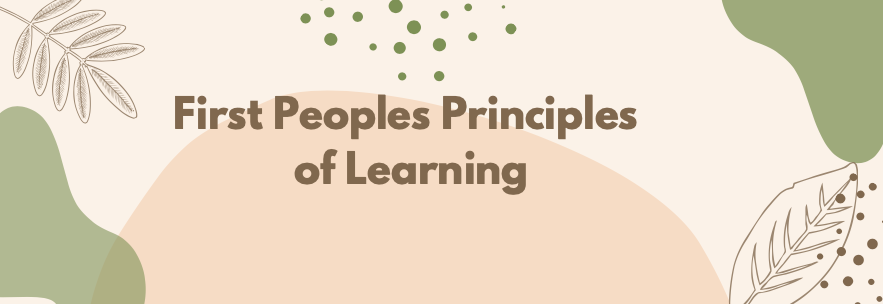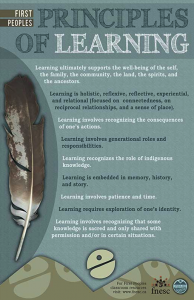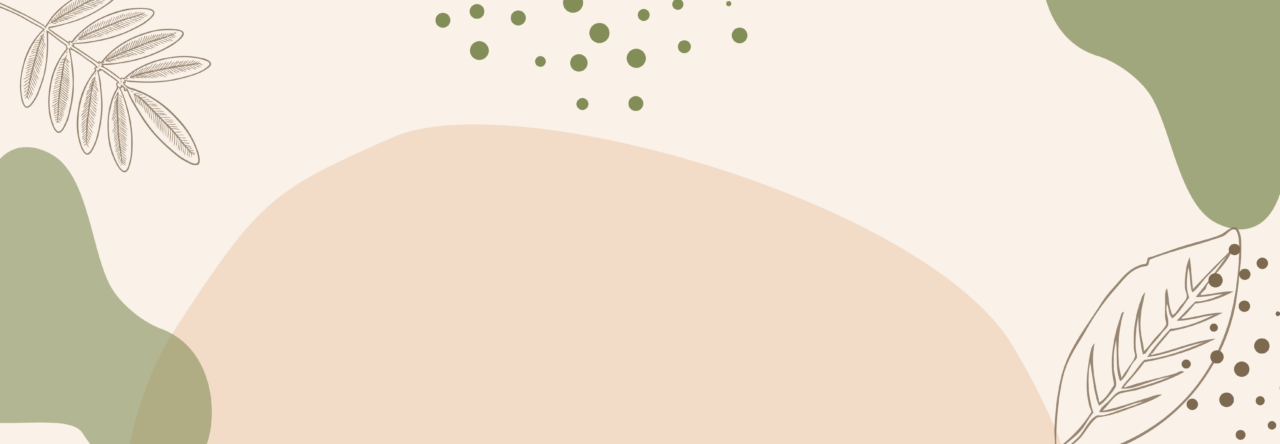
Prior to embarking on my learning journey in the B.Ed program at UNBC, I had limited knowledge of the First Peoples Principles of Learning. I had acknowledge the principles and had some understanding from my experience working as an Education Assistant. Over the course of my learning journey, I have had the opportunity to reflect on what each of the principles truly means to me and how I plan to embed the principles into my teaching practice. I’ve decided to share my paper of the First Peoples Principle of Learning that resonated with me. This paper was originally written for Educ 346 and provided me with the opportunity to reflect on what it means to me and how I will integrate into teaching.
“Learning is holistic, reflexive, reflective, experiential, and relational (focused on connectedness, on reciprocal relationships, and a sense of place)”
First Nations Education Steering Committee
The principle of learning that resonated deeply with me is, “Learning is holistic, reflexive, reflective, experiential, and relational (focused on connectedness, on reciprocal relationships, and a sense of place)” (First Nations Education Steering Committee, n.d.). This principle focuses on connection, reciprocal relationships, and place. I believe in the importance of interweaving these aspects throughout my future teaching practice because of the significance in supporting and guiding the whole student. Through these approaches, I can act as a facilitator of learning while establishing a holistic education experience that meets the needs of students through mind, body, and spirit. Without one of these elements, a need within the student may not be met, leading to an imbalance in their learning experience. As an educator, I feel it’s my duty to foster an environment that meets each individual’s needs for all my students to grow in communication, critical thinking, and personal and social development.
In my own experience, reflective and experiential learning has been the most valuable. Hands-on learning and land-based learning were the most meaningful to me. I found I was able to connect with the concepts in a more present sense, rather than learn about topics applicable only in the distant future. Being present in my learning experiences allowed me to gain a deeper connection to the content and engage in a more profound reflective practice. Through reflecting from an honest place, I felt more confident about the content I had learned and could then solidify new knowledge to achieve a deeper understanding. An example of this was during my grade 11 biology class. I had previously feared any science subject, as I had already succumbed to the belief that I was inadequate in this area. However, my grade 11 teacher took a different approach, and we conducted an experiment outside, observing plant matter and its adaptations to the changing seasons. I was better able to connect the textbook material to what I was experiencing hands-on and was pleasantly surprised by how much I learned in that class, it reflected in the high mark I achieved.
Reciprocal relationships in learning also hold significant importance in my experience. While working with students previously, I have always found that I learn as much from them as they learn from me. Each experience has taught me something new, which I carry forward with me to adapt and modify my teaching practices. The reciprocity held in these relationships offers valuable learning experiences, that if ignored, is a great loss of opportunity. I believe that fundamentally, relationships and connection are the utmost important foundation in teaching. Once this foundation is well-established, the opportunities for growth are endless.
In my future teaching practice, I hope to begin every year by laying a strong foundation with my students embedded in relationships, connections, and an understanding of their sense of place. I plan to create lessons that include cross-curricular content incorporated in different strategies, such as through land-based learning about the plant life cycles, salmon spawning, and environmental conservation. I also hope to incorporate experiential learning within the community, such as planting a vegetable garden and engaging in cedar basket weaving with an Elder visit. Additionally, I believe in the importance of reflective and reflexive learning, which can be guided through written journals, oral sharing, talking circles, role playing, etc. I plan to create a classroom environment in which students feel safe to share their learning experiences in a way that feels comfortable to them, while strengthening their new knowledge and creating opportunities to gain new perspectives. Through these practices, I hope to facilitate holistic learning that is reflexive, reflective, experiential, and relational to support and guide the whole student in mind, body, and spirit along their learning journey.
References
First Nations Education Steering Committee. (n.d.). First Peoples Principles of Learning. FNESC.http://www.fnesc.ca/wp/wp-content/uploads/2015/09/PUB-LFP-POSTER-Principles-of-Learning-First-Peoples-poster-11×17.pdf
First Peoples Principles of Learning – Poster – from FNESC
http://www.fnesc.ca/wp/wp-content/uploads/2015/09/PUB-LFP-POSTER-Principles-of-Learning-First-Peoples-poster-11×17.pdf
First Peoples Principles of Learning – Blog – by Jo Chrona from FNESC
https://firstpeoplesprinciplesoflearning.wordpress.com/
Learning First Peoples Classroom Resources – from FNESC
http://www.fnesc.ca/learningfirstpeoples/

